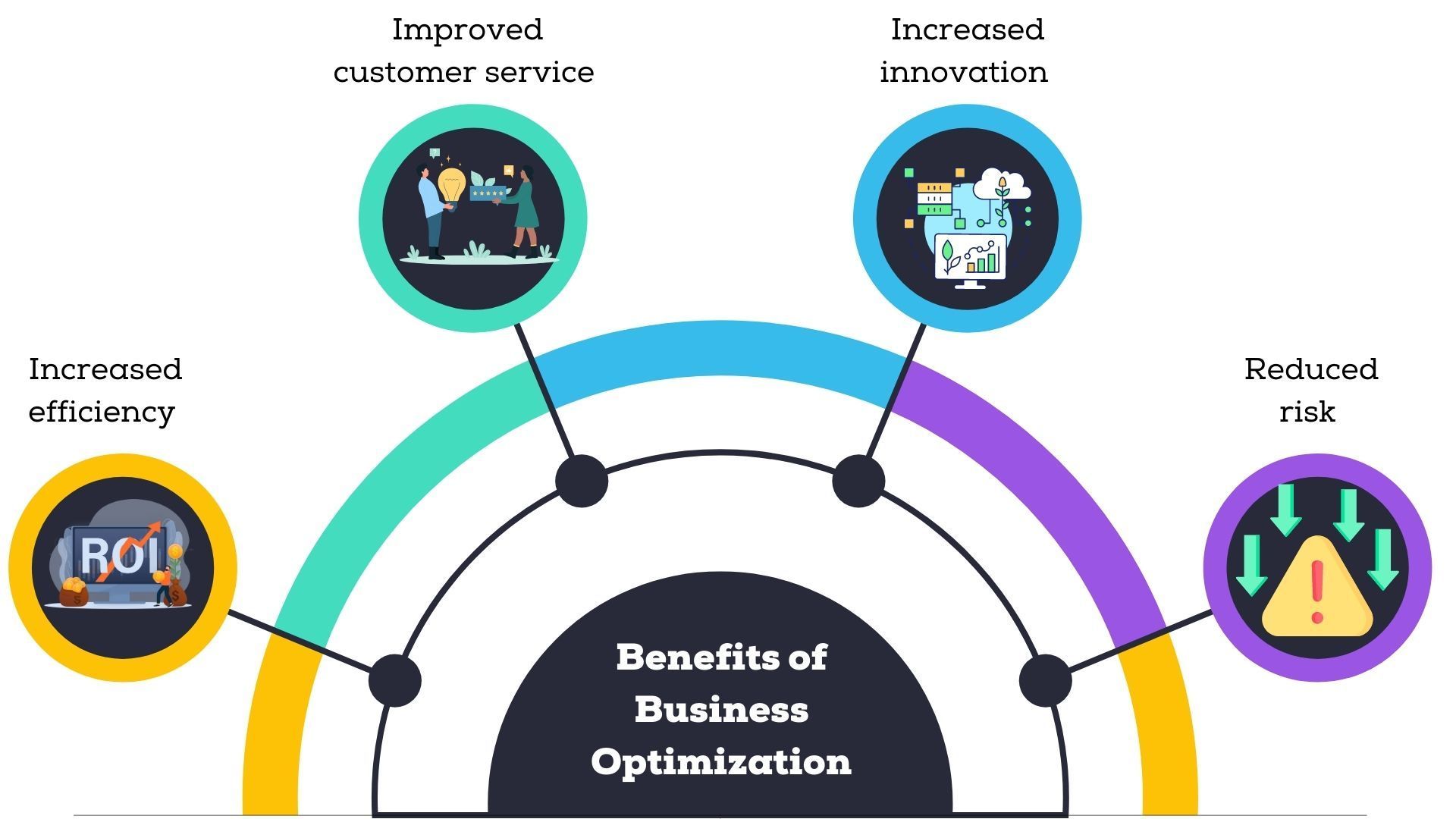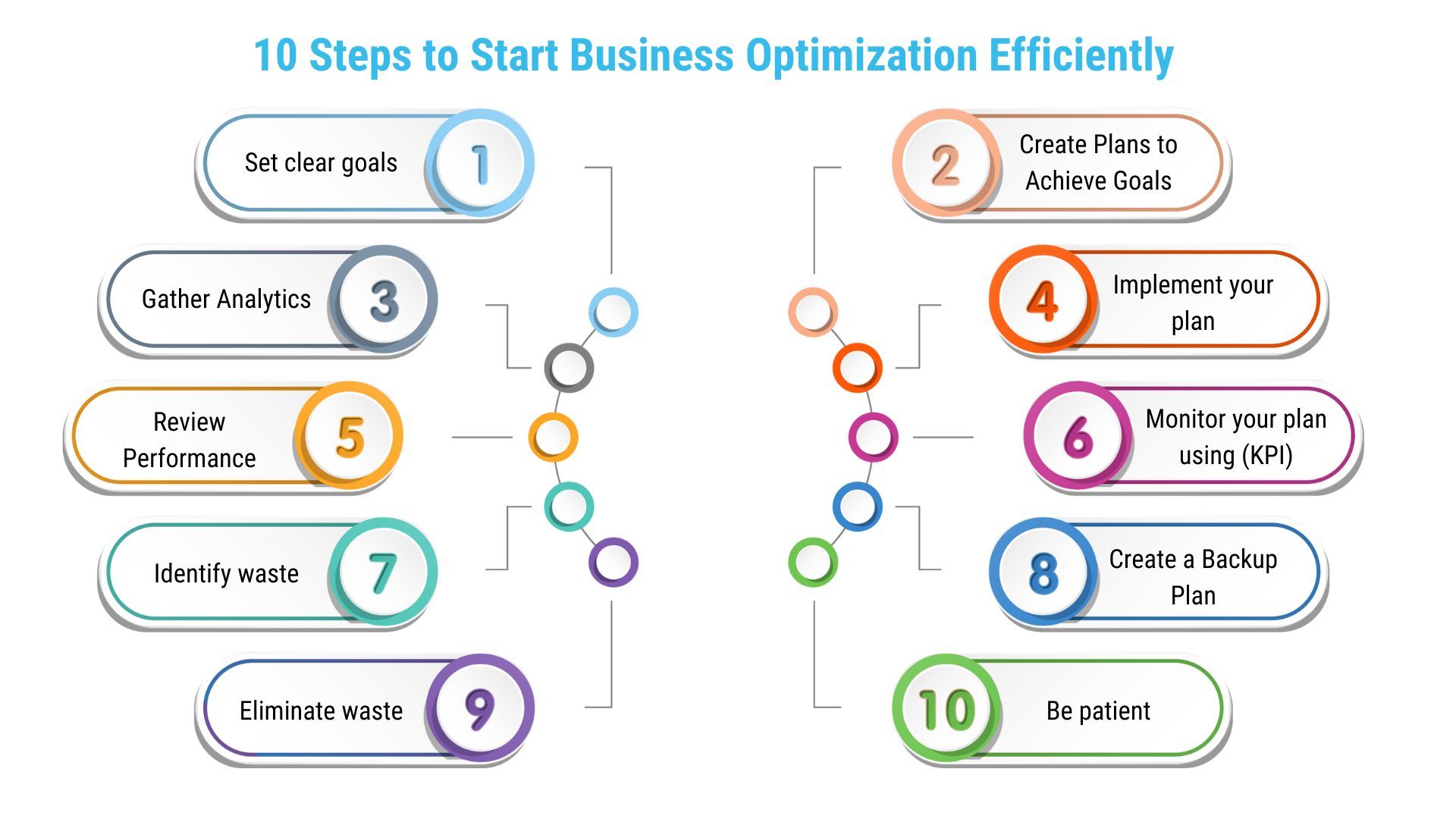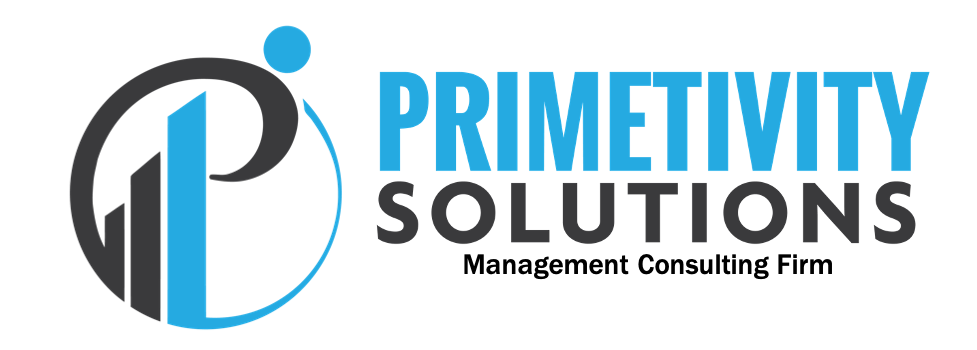Business Optimization
Improving Profits, Productivity, and Processes
As a business owner, you know there are always ways to improve your business. You may seek ways to increase sales, improve efficiency, or reduce costs. Business optimization can help you achieve all of these goals and more.
What is Business Optimization?
Business optimization is the process of identifying and implementing changes that will improve the efficiency and effectiveness of your business. This can involve anything from changing your marketing strategy to streamlining your operations and identifying and eliminating waste. The goal is to make your business more efficient and profitable.
Benefits of Business Optimization
Why business optimization is important and why you need it
Increased efficiency
Business optimization can help businesses to operate more efficiently, which can lead to lower costs and higher profits.
Improved customer service
By improving processes and using resources, businesses can provide better customer service.
Increased innovation
Business optimization can help businesses to be more innovative, which can lead to new products and services.
Reduced risk
By identifying and eliminating waste, businesses can reduce the risk of costly mistakes.

10 Steps on How to Start Business Optimization Efficiently
Set guidelines or actions that can be followed to improve the efficiency and effectiveness of a business.
Step 1 - Set clear goals
The first step to business optimization is to set clear goals. What do you want to achieve by optimizing your business? Once you know your goals, you can start identifying areas to improve.
2 Important things to include when setting goals for business:
How to value your people
Your employees are your most valuable asset, so make sure you are investing in their development and well-being. This includes providing them with the training and resources they need to be successful, as well as creating a positive work environment where they feel valued and respected. It is based on the belief that happy and engaged employees are more productive and loyal.
How to Focus on your customer satisfaction and Loyalty
Your customers are the lifeblood of your business. Without them, you wouldn't be in business. So it's important to make sure that you are always putting their needs first. This means understanding what they want and need and then providing it to them in a way that exceeds their expectations. It is based on the belief that satisfied customers are more likely to return and recommend a company to others.
These two things are essential for any business that wants to be successful. By focusing on employee satisfaction and retention, businesses can attract and retain top talent. By focusing on customer satisfaction and loyalty. Businesses can build a solid customer base that will keep returning for more.
Step 2 - Gather Analytics
You may need to review current data and previous annual reports to collect analytics.
- Website analytics - This data can include the number of visitors, the pages they visit, and how long they stay on the site. Website analytics can improve the website's design, content, and marketing campaigns.
- Social media Analytics - This data can include the number of followers, the posts they share, and how often they engage with the brand. Social media analytics can improve the brand's social media presence, increase engagement, and track the effectiveness of social media marketing campaigns.
- Production analytics - This data can include information such as the number of units produced, the time it takes to produce a unit, and the cost of production. Production analytics can improve the production process, reduce costs, and identify areas with room for improvement.
- Operational analytics - This data can include information such as the number of transactions, the time it takes to complete a transaction, and the cost of a transaction. Operational analytics can improve the operational system, reduce costs, and identify areas with room for improvement.
Step 3 - Review Performance
If you have the data, you can now review the performance of your business. Where are you currently at? What are your strengths and weaknesses? Once you have a good understanding of your business, you can start to make improvements.
Here are some additional tips for reviewing your business performance:
- Don't just focus on the numbers. It's also important to consider qualitative data, such as customer feedback and employee satisfaction.
- Be honest with yourself. If you see areas where your business is struggling, don't be afraid to make changes.
- Don't be afraid to ask for help. Many resources are available to help businesses improve their performance, such as consultants and business coaches.
- Celebrate your successes. It's important to recognize your accomplishments, even small ones. This will help you to stay motivated and keep making progress.
Step 4 - Identify waste
Once you have a good understanding of your business performance, you can identify waste in your business. Waste can take many forms, such as unnecessary steps in a process, idle time, or wasted materials. This includes auditing your applications.
Step 5 - Eliminate waste
Once you have identified waste, you can start to eliminate it. This may involve changing processes, investing in new technology, or simply making better use of resources.
Step 6 - Create Plans to Achieve Goals
Once the goal is set, and identified the weakness and strengths of the business and eliminate the waste then you can create plans to achieve the goal by using the following steps.
- Outline your objectives.
- Determine useful resources.
- Process Automation
- Brainstorm strategies.
- Write out actionable steps for your plan.
- Make a checklist to monitor progress.
Step 7 - Implement your plan
Once you have a plan of action, you can start to take steps to implement it. It is important to be flexible and adaptable as you implement your plan, as there may be unexpected challenges. However, if you are prepared and have a clear goal, you can overcome challenges and achieve your desired outcome.
Here are some tips for implementing your plan:
- Break up your goal into smaller steps that are easier to handle.
- Create a timeline for completing each step.
- Assign tasks to responsible parties.
Step 8 - Monitor your plan using (KPI) key performance indicator
It is important to measure the results of your business optimization efforts. This will help you to track your progress and make sure that you are on track to achieve your goals.
Step 9 - Create a Backup Plan
Business optimization is an ongoing process. You should regularly review your operations to identify new areas for improvement. If you're not on track to achieve your goals, adjust your plan. Don't be afraid to try something new if things aren't going well.
Step 10 - Be patient
Optimization is an ongoing process. It takes time to make changes and see the effects of those changes. If you are patient and keep trying, you will get where you want.

Who Can Help Optimize Your Business?
If you're looking to optimize your business, you're not alone. Many businesses struggle to find the time and resources to make necessary improvements. So, who exactly can help optimize your business? Let's explore together.
1. Business Consultants
The first beacon of assistance comes from seasoned business consultants, much like the dedicated team here at Primetivity Solutions. We specialize in understanding the intricacies of your business operations, identifying potential growth areas, and crafting bespoke strategies to help you leap forward.
We firmly believe in individuality - every business has a unique story to tell and, thus, a unique path to tread. We're here to listen, learn, and aid in charting out your success journey, one optimization at a time.
2. Industry Experts
Business consultants offer a bird's eye view, while industry experts dive deep into the trenches. Their nuanced understanding of specific sectors – from healthcare to retail, technology to manufacturing – can help uncover unique opportunities and trends to align your business with the industry’s best practices.
3. Data Analysts
In an era where data is the cornerstone of decision-making, data analysts are your knights in shining armor. By digging deep into your business data, they can help spot trends, monitor key performance indicators (KPIs), and make well-informed recommendations that will steer your business toward its goals.
4. Your Team
Your team – the heart of your organization, holds unmatched insights into its day-to-day operations. Involving them in the optimization process not only boosts morale but also opens up avenues for unique internal perspectives that can lead to significant improvements.
5. Customers
The voice of your customers is the ultimate compass guiding your business optimization. By actively seeking their feedback, understanding their needs, and adapting to their expectations, you're paving the way for a business that survives and thrives in its market.
In essence, business optimization is a symphony, one that beautifully harmonizes the strategic vision of business consultants, the deep insights of industry experts, the data-driven prowess of data analysts, the ground realities from your team, and the invaluable feedback from your customers.
Final Thoughts
Business optimization is no longer a luxury but a critical strategy for sustained success in an increasingly competitive global marketplace. It enables businesses to streamline operations, increase efficiency, minimize waste, boost customer satisfaction, and ultimately enhance profitability.
Business optimization is an intricate process that requires precise goal setting, meticulous data analysis, and ongoing performance review. By identifying and eliminating waste, businesses can reduce costs and risks while enhancing efficiency and service delivery. Emphasizing people's value and focusing on customer satisfaction and loyalty are integral elements of successful optimization.
Automation and technology are pivotal in business optimization, providing the tools to refine processes and significantly reduce waste. Monitoring key performance indicators (KPIs) ensures that the implemented changes yield the desired outcomes and enables businesses to adjust their strategies in real time.
However, the business optimization journey is often long and challenging and requires patience, persistence, and adaptability. It's not a one-time fix but an ongoing process that demands consistent monitoring, review, and improvement.
Remember, you don't have to go it alone. Business consultants, industry experts, data analysts, your team, and customers can provide invaluable insights and assistance. Each contributes a unique perspective, forming a harmonious symphony of strategies to propel your business forward.
At
Primetivity Solutions, we're here to help you navigate the path of business optimization. Our dedicated professionals will work closely with you to understand your unique needs and challenges and develop tailored solutions that drive growth and success. Our holistic approach combines strategic vision, industry-specific insights, data-driven strategies, and a deep understanding of your operational realities to help you optimize your business.
The journey of business optimization is a transformative one that redefines not just your business processes but your entire business ethos. It's about creating a business surviving and thriving in an ever-changing landscape. Let's embark on this journey together. Contact
Primetivity Solutions today for personalized business consultation, and let's co-create a future optimized for success.
FAQs
What is the purpose of business optimization?
The purpose of business optimization is to empower organizations to become more profitable, efficient, customer-centric, innovative, and adaptable. It's a strategy that places the company on a trajectory of sustained growth and success.
What is the optimization model in business?
An optimization model is a mathematical model that helps businesses make decisions by finding the best solution to a problem. It does this by considering all of the possible options and choosing the one that will produce the best outcome. Optimization models are used in a variety of businesses, including manufacturing, transportation, and healthcare.
Here are some examples of how optimization models are used in business:
Manufacturing: Optimization models can be used to determine the best way to allocate resources, such as labor and materials, to produce a product.
Transportation: Optimization models can be used to determine the best way to route vehicles or shipments.
Healthcare: Optimization models can be used to determine the best way to allocate resources, such as doctors and nurses, to provide care to patients.
Optimization models can be a powerful tool for businesses to improve their efficiency and profitability. But using them may be challenging and complicated. Businesses considering an optimization model should consult a qualified expert to ensure it is the right solution for their needs.
What is an example of business optimization?
Business optimization is the process of improving the efficiency and effectiveness of a business. There are many strategies, including:
Improving processes
Automating tasks
Reducing costs
Increasing revenue
Improving customer satisfaction
One example of business optimization is the use of automation to reduce costs. For example, a business could automate its customer service by using chatbots to answer frequently asked questions. This would free up human customer service representatives to focus on more complex issues, and it would also reduce the cost of providing customer service.
Another example of business optimization is using data analytics to improve decision-making. For example, a business could use data analytics to identify which products are most popular with its customers. This information could then be used to decide which products to stock, which marketing campaigns to run, etc.
Business optimization is an ongoing process, and there is no one-size-fits-all solution. The best approach for a particular business will depend on its specific needs and goals. However, by implementing some of the abovementioned methods, businesses can improve their efficiency and effectiveness and, ultimately, their bottom line.
How does Primetivity Solutions help businesses optimize their operations?
Primetivity Solutions uses a combination of advanced analytics, business intelligence, and seasoned expertise to help businesses streamline their operations, improve efficiency, and increase profitability. We also provide tools for customer relationship management, inventory management, and process automation.
What industries do you cater to?
Primetivity serves various industries, including retail, manufacturing, finance, healthcare, and technology. We customize our optimization strategies to suit the unique needs and challenges of each industry.
What is the cost of your services?
The cost of our services varies based on the specific needs of your business and your budget. After an initial assessment, we will provide a custom quote that reflects the services you require. Our objective is to maximize the return on your investment. Additionally, we offer a free 15-minute consultation with our business scientist.
How can I get started with Primetivity Solutions?
Getting started with us is easy. Simply contact us via our website or call (912) 310-5001. One of our consultants will discuss your needs and guide you through the process of integrating our services into your business.
Phone:
Email:
Business Hours:
- Mon - Fri
- -
- Saturday
- -
- Sunday
- Closed
